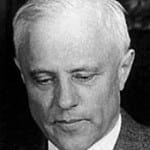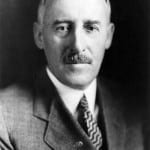Nagasaki: The Forgotten Victim of Nuclear Terror.
//
=By= Murray Polner

CC BY-SA by AK Rockefeller
[dropcap]Y[/dropcap]Years ago, on a troopship returning from Japan, I spoke with a Japanese wife of an American airman. She told me she’d been born and raised in Hiroshima and after the first A-Bomb raid on August 6, 1945, her parents sent her to Nagasaki for safekeeping just in time for the second A-Bomb attack.

Karl Compton
She was among the lucky ones who escaped with their lives. But 75,000 people were killed in Nagasaki (and at least 100,000 in Hiroshima) and many more suffered for decades from excruciating and lingering ailments. Hiroshima and Nagasaki had followed the conventional American carpet bombing of Tokyo and Yokahama, which was meant to break the morale of the Japanese people. When news of the two atomic raids was announced most Americans cheered since they believed the authoritative figures who told them the attacks had helped end the war and saved many American military lives.
Those convincing voices included MIT’s president and eminent physicist Karl Compton whose Atlantic Monthly article claimed the attacks saved “hundreds of thousands—perhaps several million—of lives, both American and Japanese.” Soon after, Henry L. Stimson, the highly-regarded former Secretary of War, assured Americans in Harper’s that the attacks were the most effective way to end the war and save lives. And no less an authority than General Leslie Groves, commander of the Manhattan Project, told the nation that “The atomic bomb is not an inhuman weapon” and “anyone who doubts this is that we did not start the war, and if they don’t like the way we ended it, to remember who started it.”

Henry Stimson
Even so, Susan Southard’s “Nagasaki: Life After Nuclear War” denigrates the NY Times’ William Laurence as “the War Department’s mouthpiece.” Laurence, she writes, worked for the Manhattan Project while still on the Times’ payroll, and wrote “his glorified account of the Nagasaki atomic bombing (from his vantage point aboard the companion plane the ‘Great Artiste’”) for which he won a Pulitzer Prize in 1946.
It was all part of an effort, Southard says, to “shut down public criticism” though ignorance about nuclear war’s consequences might well have been a contributing factor.
0rdinary Japanese also knew little about what had happened on August 6 and 9 since its newspapers and radio had been censored throughout the war and later by the American occupiers.
Still, to their credit, not every military leader followed the party line. The Associated Press quoted Admiral William “Bull” Halsey, commander of the Navy’s Third Fleet, questioning the use of the A-Bombs since the Japanese were on the verge of surrendering. Admiral William D. Leahy, chief of staff to FDR and Truman, angrily wrote in his book “I Was There” that “we had adopted an ethical standard common to the barbarians of the Dark Age” and “wars cannot be won by destroying women and children.” And in Dwight Eisenhower’s memoir, “Mandate for Change,” he told Stimson of his “grave misgivings” about the use of the A-Bombs. Halsey, Leahy and Eisenhower were not alone.
Trying to introduce some balance and clarity, Southard quotes John Dower, Pulitzer historian of Japan and WWII (he blurbed her book): “No one denies that these policy makers desired to hasten the war’s end and to save American lives but no serious historian regards those as the sole consideration driving the use of the bombs on Japanese cities.” Certainly the emerging rivalry with the Soviet Union played a crucial role.
“Nagasaki” is an empathetic, meticulous and lucid account of the city and its victims, especially since the city has always lived in the shadow of Hiroshima. An independent writer, Southard is the founder and artistic director of Essential Theater in Tempe, Arizona, who first encountered the Nagasaki story when, as a teenage exchange student, she visited a memorial museum in the city and later learned enough Japanese to be able to serve as a translator for a survivor of the attack on an anti-nuclear US speaking tour.
This necessary book will no doubt remind many of John Hersey’s seminal “Hiroshima,” where one of his survivors “wondered why they lived when so many others died” and another “who saw more death that he ever thought he would see.”
Inside the devastated city survivors (called Hibakusha), scoured neighborhoods, streets, workplaces, schools and hospitals for missing relatives and friends. For some it was too much, drinking “excessively to escape their exhaustion, loss and shame, “killing themselves or suffering lingering and painful deaths. Beyond grief and wounds there were hard times. “[E]conomic stability did not come for many years except for wealthy business barons who had amassed enormous profits during the war; most families faced unrestrained financial distress.”
Southard goes beyond the immediate horrors and concentrates on the aftermath of the attack. Young survivors who became anti-nuclear activists were spurned by Japanese conservatives who played down Japan’s many WWII war crimes by insisting the two nuclear attacks were infinitely worse.
So savage a war left irreconcilable protagonists in its wake. In 1988, when the Smithsonian National Air and Space Museum tried –in Southard’s words—“to simultaneously celebrate the end of a horrific war and—while refraining from drawing conclusions about the morality of the bombs’ use—remain compassionate to those who experienced the bombings. American veteran groups and their congressional allies were furious because they believed the exhibit belittled their courage and suffering and emphasized instead Hiroshima and Nagasaki. The exhibit was forced to eliminate a good deal of relevant material including Eisenhower’s opposition and virtually all survivor accounts.
Nagasaki’s mayor was irate and after apologizing for Pearl Harbor and Japan’s war crimes he memorably added, “But do you tell me that because of this aggression and these atrocities committed by the Japanese, there is no need to reflect upon the fact that an unprecedented weapon of mass destruction was used on a community of noncombatants.”
Eight years later the same thing happened in Japan when the Nagasaki Atomic Bomb Museum added exhibits documenting Japanese war crimes and conservative Japanese rose in protest and forced the museum to eliminate, among other wartime horrors, the Bataan Death March, the treatment of POWs, the rape and slaughter of countless Chinese civilians, and other war crimes
Meanwhile, survivors were meeting bureaucratic hurdles, “exasperated and undeterred,” fought back legally and politically. At a rally in 1980, Yamaguchi Senji, who had lost many relatives to radiation sickness, heatedly declared, “0ur demand for the immediate enactment of a law for the relief of all Hibakusha is not only a Hibakusha demand, but also the demand of all people in Japan, and of the whole world, for ‘No More Hibakusha!.”
Southard also describes how eleven years after the bombing, 10-12,000 Korean atom bomb survivors had to fight for the identical health benefits granted Japanese survivors because they were required to have a Japanese witness attest to their identity, leading one Korean to ask, “All my neighbors died of the bomb. How could you bring them? Bring a ghost?”
The survivors’ refusal to remain silent has helped foster worldwide anti-nuclear sentiment. What also ultimately helped them and most Japanese was a generous American occupation, which installed a pacifist constitution unambiguously stating, “The Japanese people forever renounce war and the threat or use of force,” an explicit clause now being altered by a conservative Japanese government and probably supported by the US as it eyes China as yet another potential enemy.
I believe Southard’s major contribution is that, given the ownership of nuclear bombs by so many nations, she forces us to think that, sadly, any city anywhere in the world could one day be on some rogue nuclear nation’s agenda.
 Contributing Editor, Murray Polner wrote “No Victory Parades: The Return of the Vietnam Veteran“; “When Can I Come Home,” about draft evaders during the Vietnam era; co-authored with Jim O’Grady, “Disarmed and Dangerous,” a dual biography of Dan and Phil Berrigan; and most recently, with Thomas Woods,Jr., ” We Who Dared to Say No to War.” He is the senior book review editor for the History News Network.
Contributing Editor, Murray Polner wrote “No Victory Parades: The Return of the Vietnam Veteran“; “When Can I Come Home,” about draft evaders during the Vietnam era; co-authored with Jim O’Grady, “Disarmed and Dangerous,” a dual biography of Dan and Phil Berrigan; and most recently, with Thomas Woods,Jr., ” We Who Dared to Say No to War.” He is the senior book review editor for the History News Network.
Note to Commenters
Due to severe hacking attacks in the recent past that brought our site down for up to 11 days with considerable loss of circulation, we exercise extreme caution in the comments we publish, as the comment box has been one of the main arteries to inject malicious code. Because of that comments may not appear immediately, but rest assured that if you are a legitimate commenter your opinion will be published within 24 hours. If your comment fails to appear, and you wish to reach us directly, send us a mail at: editor@greanvillepost.com
We apologize for this inconvenience.
 Nauseated by the
Nauseated by the
vile corporate media?
Had enough of their lies, escapism,
omissions and relentless manipulation?
Send a donation to
The Greanville Post–or
But be sure to support YOUR media.
If you don’t, who will?